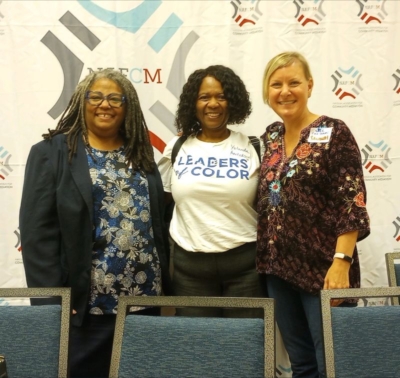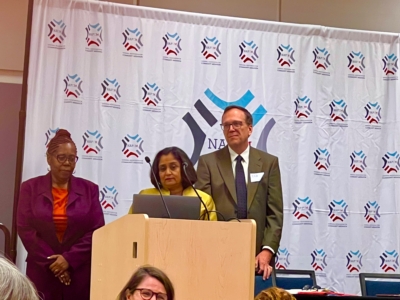
Just about a year ago, I wrote a blog post about community mediation after my first meeting as a member of the National Association for Community Mediation’s (NAFCM) board of directors. I hadn’t been able to physically attend the three-day retreat because I wasn’t yet ready to travel given the pandemic. This year, I went, prompted not only by the improving public health situation but by the fact that the meeting was held five miles from my house at George Mason University’s Carter School of Peace and Conflict Resolution and was followed by NAFCM’s first national assembly of its members this Monday and Tuesday.
 As I looked back at what I wrote 53 weeks ago, I realized how much more enthusiastic I am about NAFCM and its mission. Last year’s post was far from downbeat, but I’ve learned a lot about its work and the need for ramping up its efforts in the last year and in the last few days that have convinced me to ramp up my own efforts, beginning with this post.
As I looked back at what I wrote 53 weeks ago, I realized how much more enthusiastic I am about NAFCM and its mission. Last year’s post was far from downbeat, but I’ve learned a lot about its work and the need for ramping up its efforts in the last year and in the last few days that have convinced me to ramp up my own efforts, beginning with this post.
What I wrote still holds but I would make the case I made even stronger
NAFCM and community mediation in general are the best kept secrets in American peacebuilding today. So, let me use this post to make that case and, more importantly, lay out a course getting community mediation out of its best-kept-secret rut in ways that were driven home this week at GMU.
The State of Community Mediation Today
I expected to learn a lot about what NAFCM centers actually did during the course of the long weekend. I didn’t expect to be quite this excited.
I knew that there were several hundred centers scattered around just about every state in this country and Canada. I knew, too, that they all drew their inspiration from the Civil Rights Act of 1964 that created the Community Relations Service, now housed in the Department of Justice, and called for the creation of community mediation centers that would be open to all, including those who were unable to pay for its services.
I was not prepared for the diversity of what those centers do. That starts with the people who came to the assembly itself. There were simply more people of color and young attendees than you usually find in peacebuilding gatherings.

More importantly for our purposes here, they do lots of different things. Some of their work is anchored in the legal system because their centers get a lot of their funding through services mandated by state and local courts. Some are even housed within state and local governments themselves. The most successful community mediation center in t Washington has an office that serves residents in each of the state’s thirty-nine counties.
The more interesting ones, however, do far edgier and more innovative work. Some focus on policing, evictions, public health, and other racially justice tinged issues that been in the headlines since the start of the 2020s. Recent funding has allowed centers to expand their work into rural areas so that they can take community mediation into Native American communities as well as expand our efforts in what are traditionally thought of as “red states.”
It has formed partnerships with the TRUST network and others who are working to limit electoral and other forms of political violence in the months leading up to next year’s election. It works with Living Room Conversations in a project aimed at fostering civility and constructive dialogue in the work of local school boards.
The Best Kept Secret in American Peacebuilding
Alas, NAFCM is the best kept secret in the peacebuilding field. That’s the case because it suffers from a syndrome facing every but hits NAFCM particularly hard. It doesn’t have enough money which means that it neither can get much publicity or develop the capacity to grow itself or help its member centers expand their efforts and/or impact.
I was shocked to learn that NAFCM’s own budget is about $300,000 a year, almost two thirds of which is distributed to members to support their work. That comes in the form of grants to support new projects but also in some basic infrastructural support, including Zoom licenses for every member center that needs one. And that grant is due to expire. That means that NAFCM’s remarkable president, DG Mawn, only works half time—although he seems to be available 24/7. Many individual centers operate on a shoestring budget of their own.

To my delight, however, the board agreed to tackle the budget and its related effects. We pledged to raise at least another $100,000, including money to help us build NAFCM’s capacity to define and implement new projects. We agreed, too, to strengthen its existing partnerships with the Alliance for Peacebuilding, Living Room Conversations, the TRUST Network, and more. We also decided to explore new ones with other locally based peacebuilding initiatives, most notably with Rotary. Last but by no means least, we will help our member centers strengthen their relationships with local policy makers while NAFCM works with AfP and others to shape national policy making, including expanding the amount of money in the. Federal budget for this kind of work.
The Irony of the Day We Met
The need for community mediation and almost everything else peacebuilders do in the United States was vividly apparent to us while we met on Tuesday. No one reading this post needs to be reminded that at just about the moment that our assembly ended, the House of Representatives voted to remove Kevin McCarthy as Speaker of the United States House of Representatives. It was hard not to juxtapose withe promise of American peacebuilding with the dysfunctional nature of political life in Washington these days.
NAFCM is not THE answer, but it it AN answer and one that I’ve pledged to help chart both with my limited checkbook and my limited organizational skills.
The views and opinions expressed in this article are those of the author and do not necessarily reflect the official policy or position of the Alliance for Peacebuilding or its members.
